The Secret of Successful A GUIDE TO BRICKLAYING TOOLS
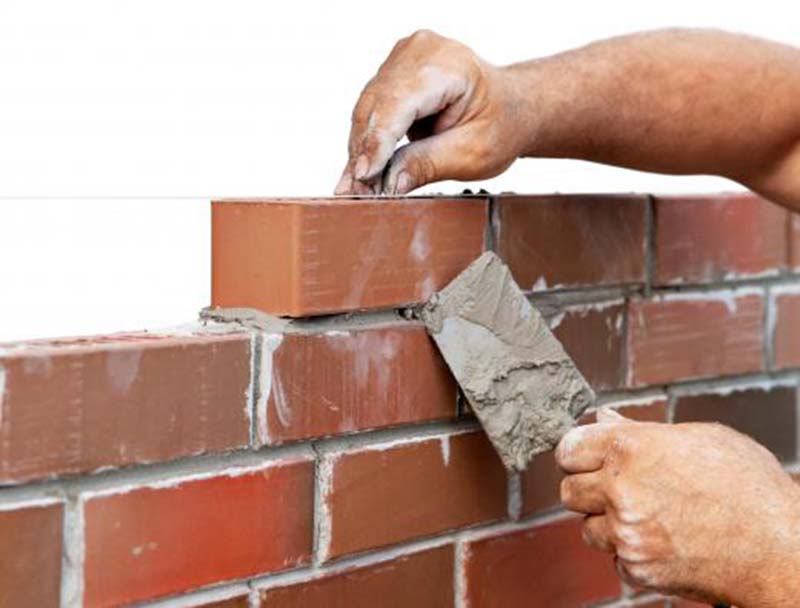
SHOULD I BE A BRICKLAYER? An Incredibly Easy Method That Works For All
Are you thinking about starting a Bricklaying Apprenticeship? Are you wondering if becoming a bricklayer is something you'll enjoy? Here's a few comments from our experience to help you suss out if bricklaying is right for you.
We hope that this introduction helps you make a decision about whether or not bricklaying is the right career for you. If you're still undecided after reading through this, be sure to chat with some bricklayer to get an idea of what the work is all about.
A bricklayer’s job is to create and maintain structures, walls, chimneys, walkways and foundations using various types of blocks and tiles. He generally works on residential, commercial or industrial projects. Although he normally works with a team of construction workers, he may also work alone.
While bricklayers used to only use traditional bricks and concrete cinder blocks, with the advancement of technology, building materials have become more diverse and more fashionable. Bricklayers today not only build with structural bricks, marble blocks, and terracotta blocks, but can also use blocks made of glass or plaster. The most common material used to bond these materials is still mortar, which has been used as an adhesive for centuries.
Under the supervision of a general contractor or masonry contractor, bricklayers typically begin a project by measuring and marking the area where construction will take place. He then calculates the amount of material needed, usually including only the chosen building material and mortar. So once the materials and tools were in place, the building process began.
Laying bricks is a precise skill that requires years of practice to master. The bond between the blocks or bricks that is secured by the mortar is one that needs to be consistent from top to bottom and sides to sides. This consistency is vital in order to create a sturdy wall or floor. If the mortar is not consistent, the blocks will not fit together properly and the result will be a structure that wobbles or leans.
The mortar must have the correct viscosity to make the layers of bricks properly stick together. It must also have the correct amount of moisture to prevent it from becoming too thick to work with during the construction session. If the consistency is not right, the structure will collapse upon being exposed to weight or environmental elements.
If you're a student, you've probably heard your teachers or professors talk about consistency. Maybe you've even heard other people talk about how important it is to be consistent. So what does it mean to be consistent? Consistency is all about being the same over time.
Another skill required by the bricklayer is to ensure the uniformity of the bricks or blocks. While factory-produced materials are fairly uniform on all sides, salvaged bricks, often used for their historical significance or weathered appearance, are often misshapen. In these cases, the bricklayer is commonly required to use a trowel, chisel, brick cutter or combination thereof to shape and carve the bricks to match the others.
As the project progresses, the bricklayer finishes each layer of his work by smoothing the mortar in between the layers of brick with the pointed tip of his trowel. This task is also commonly performed using a piece of copper tubing to smooth and create a glassy finish on the connecting mortar layers. Before the project can be considered complete, all stray pieces of mortar or brick chips must be removed from the surface. Any remaining debris can potentially cause further damage to the property.
Apprentice bricklayers typically require a high school diploma or equivalent to enter an apprenticeship program, which is often considered the best route to becoming a professional in the field. The skills learned during an apprenticeship are typically much more comprehensive than those gained through on-the-job training, and apprentices receive a steady income while they learn.
Programs typically last 3 to 4 years, and apprentices are expected to work 40 hours or more per week during this time. Some programs are combined with college coursework related to masonry, which can reduce the overall time needed to complete an apprenticeship.
1) Good salary
Honestly, it's certainly not the highest paying job in the world, but it gets very comfortable as you progress. A big plus is that getting out of debt is relatively easy because you start making money from day one.
Apprentices usually start with an hourly wage and their school or course is paid for by the company. Most companies expect new hires to have their own hand tools, while offering more expensive power tools at their disposal. When the apprenticeship ends, a qualified bricklayer may be able to negotiate a wage per brick/block or per square meter/foot, which works well for a good bricklayer.
Some bricklaying companies pay a fixed weekly wage, usually slightly lower, but this is guaranteed. Other companies pay you for the hours you actually work, which means you won't get paid if you can't work because the workload is too high. Because of this risk, these employers often pay higher wages and try to get a job on those rainy days.
Average salary for bricklayers in the UK
In the UK, an apprentice bricklayer earns around $26,925 a year. Once they qualify, the annual income rises to about $44,852. Over time, experienced bricklayers earn about $59,803 per year.
Average U.S. Bricklayer Salary
In the United States, an apprentice bricklayer earns about $29,250 a year. Once they qualify, the annual fee rises to about $46,313. Experienced bricklayers can earn about $78,000 a year.
Average salary of bricklayers in Australia
An apprentice bricklayer in Australia earns around $39,802 a year. Once they qualify, annual income rises to about $63,700. More experienced bricklayers make about $103,740 a year.
2) External work
For most bricklayers, the thought of being stuck inside day after day sounds frustrating. If that's how you feel, bricklaying might be a good option. It's true that working outdoors has a lot of downsides. Winter mornings can start brutally cold and the rain can get depressing. Most of the time, you and your clothes come home covered in brick dust and mortar. Washing machines can also take a hit if you're not careful.
But trust me, you've learned to use these things, it's definitely useful. Dress warmer in the morning, and you'll develop good washing habits when you get home from get off work. What someone has tried is throwing dirty clothes into a bucket of water, wiping off the mortar before it hardens, shoving the water out along with the brick dust, and throwing it in the washing machine. We all know it sounds terrible, but those days of working in the sun and fresh air make it so worth it.
3) Satisfaction with the work that has been done
This might not sound that important now, but it's a great feeling when you're done building, it looks good and the client is happy. There's not a lot of work out there to get that kind of satisfaction from bricklaying. This even includes some other deals. I've never heard a flamboyant brag about his wiring or a plumber about his plumbing.
By laying bricks, you can see what you have done in a day. Not only will the buildings and walls you build be here forever, every time you drive by in the future you can tell everyone that you built it.
4) Good training activities
If you're going to lay bricks straight from school, that's a wake-up call. It starts when it's still dark, and then the physical labor of throwing things around bricks and blocks throughout the day takes some getting used to. In the end though it teaches you a valuable lesson on how to work hard.
Many people put off bricklaying after a few weeks because they can't handle the physical aspects of the job. Honestly, there are easier jobs out there. You just have to get through those early days and your body will get used to the daily punishment. In fact, as long as you're not stupid about lifting heavy objects and protect your eyes and ears with some good equipment, you'll consider a day's bricklaying like a good workout.
Even if you decide to hang up your trowel for other things in the future, the experience of laying bricks will be invaluable, how to work hard without complaining, how to work with a team, how to be productive. These skills will stay with you forever.
5) Always have a job
There is a shortage of skilled bricklayers in many countries of the world. This means that once you've been trained and honed your skills, it won't be hard to find a job. You can even choose a company that is right for you. Back in the Middle Ages, after someone completed their apprenticeship, they would become a journeyman. Skilled unions move from town to town, gaining valuable experience and training from different workhouses.
Today, many masonry companies will specialize in a particular area of the industry. For example, some businesses specialize in commercial block laying, others specialize in masonry, others specialize in brick landscaping, etc. The key is to master many aspects of bricklaying. If there is a type of masonry that you like or want to get better, why not join a company that specializes in that field.
You are not even limited to the country and region where you live. Many bricklaying qualifications are recognised internationally, and while circumstances will vary from country to country, these qualities are quickly discovered.
6) Possibility of entrepreneurship in the future
The advantage of being a brick home is that you can start your own business and hire your own gang very quickly. Start-up costs are usually quite low compared to other businesses. Remember, just because a bricklayer can make decent bricks, doesn't mean they have what it takes to be their own bosses.
If your goal is to start a company, plan early. As an employee, you can start accumulating some needed power tools and extra gear. Purchase the right work vehicle. Some bricklaying companies are willing to train you on the business side. Learn as much as you can about quotes, order materials, and then deal with customers and suppliers.
Once you have successfully started your own brick and mortar business, not only will you make more money, but you will have the flexibility to do the work you want when you want.
7) Future-proof
Every now and then, we hear some experts say, "Bricklaying is a dying business." Don't worry it's far from the truth. According to market research, the global concrete brick and block industry is expected to grow by 4% over the next two decades.
With the gradual retirement of older bricklayers, coupled with the growth of the market, brick-making companies are no longer worried about selling their product, but worry about not having enough bricklayers to lay it. This is still there, although competition from new exterior cladding products will continue to increase.
The future of bricklaying looks very safe as people want to use brickwork because it has many benefits:
a. it is maintenance free
b. is insulating
c. it is fireproof
d. It is insect and rot proof
e. It stops projectiles during storm events
f. looks great
g. It now performs well even during earthquakes
Interesting Facts I Bet You Never Knew About HOW TO BECOME A BRICKLAYER - MASONRY APPRENTICESHIPS
If you have decided that you want to Become a Bricklayer, How do you get into the Industry?
No doubt you will have more questions regarding the process of becoming a bricklayer:
Should you become a Labourer (Hod Carrier / Tender / Helper) before starting a Bricklaying Apprenticeship?
What are Masonry Companies looking for in new employees?
Do you even need to go through with a formal qualification and apprenticeship?
Is it a good idea to join a bricklayers union, or contact a bricklayers association?
In English, a bricklayer is colloquially known as a "brickie". A stone mason is one who lays any combination of stones, cinder blocks, and bricks in construction of building walls and other works. Bricklaying is a part of masonry. Although the exact process is going to be different depending on where you live, many countries have similar pathways. In fact if you live in America, the UK, Canada, Australia or New Zealand options to becoming a qualified bricklayer are basically the same.
The most common and best way to train a bricklayer is through an apprenticeship program. This means you will be paid as you learn and have skilled bricklayers supervise your training. With the tightening of permits in the construction industry, you will open up more jobs without fear.
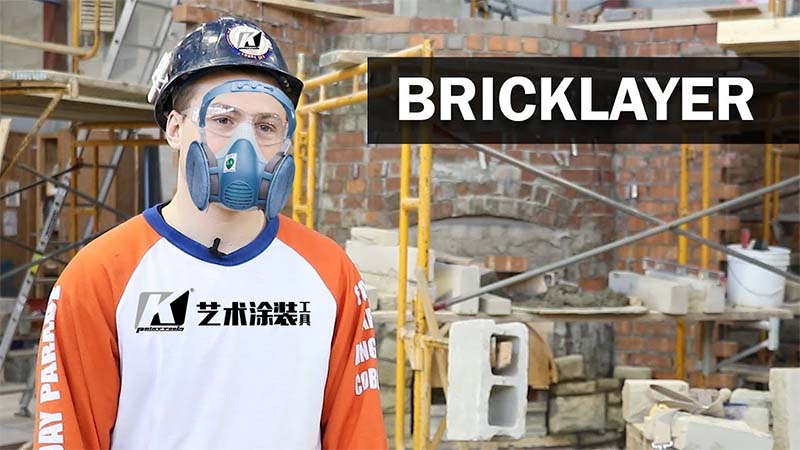
4 PATHS TO BECOME AN APPRENTICE BRICKLAYER:
Take a Job as a Bricklayers Labourer
Straight through a Bricklaying Company
Take a Pre Apprenticeship or Gateway Course at a Technical College
Join a Trade Union or Contact a Bricklayers Association
a) Work as a bricklayer
Labourers are also known as porters, bidders or helpers, depending on which country you are from. No matter what you call it, working for a bricklaying company is going to be very hard work. The good news is that there will be plenty of jobs available because good workers are hard to keep. If you can show that you are willing to work hard without complaining, many masonry companies will hire you because you have no previous qualifications or experience.
Starting out as a worker will teach you many useful skills for the ultimate goal of becoming a mason. You'll learn how to make the perfect mortar brew, safely cut bricks, how to set up mortar boards and piles, and use the mortar joint tool. It thickens your skin and teaches you how to follow directions.
Perhaps more importantly, starting as a worker will get you into the industry. You will be employed by a masonry company and be able to develop a good relationship with the boss and the rest of the team. You can even start connecting with other bricklaying businesses in your area.
The real risk, however, is becoming a laborer. Because good hood carriers can be hard to find, company owners may be hesitant to push them to learn to lay masonry. Even if a worker has years of experience, that doesn't translate directly into laying good bricks. You may see how it's done, but your training won't start until you're on the trowel.
There are some ways to avoid this possibility. Make sure to express your desire to start a masonry apprenticeship early on. If the boss knew early on, it would give you time to plan and maybe find a replacement for your job position. Ask the bricklayer if you can practice it during your breaks, and ask them for some bricklaying tips to help you improve. If you feel like you're going to be stuck as a worker, don't be afraid to switch to another company. Apprenticeship with other people is a little easier with your labor experience.
So do you need to be a worker before starting a bricklaying apprenticeship?
You certainly don't need to, but it will help you get used to the construction site and teach you the theory of bricklaying. Just make sure to set a time limit for being a laborer, maybe a year.
b) Directly through the bricklaying company
It's hard to get an apprenticeship out of the cold unless you already know a contractor. Especially with zero experience. Having said that, it is possible.
Many of the masonry jobs advertised online or elsewhere are for experienced bricklayers. If you do see someone offering an apprenticeship program, hop on it. Although you will most likely have to search for a listing of masonry companies in your area and give them a call.
If you have no masonry experience, completing a high school certificate or equivalent can help. Especially if you excel in courses like math, hard material design techniques, or technical drawing. There are a lot of things to keep in mind when talking to owners of masonry businesses - as apprentices typically lose money in the first year and then break even in the second, it's important to show that you're looking at the long term. Let everyone know that a bricklaying apprenticeship is something you really want to do, and it's not just a hasty decision.
Employers will be looking for people who are willing to work hard and who can listen and follow directions. One reason employers may prefer apprentice bricklayers to already qualified ones is that they have the opportunity to train them the way they want. So show your enthusiasm for learning.
Being physically fit may help convince your boss that you are up to the job. You can even buy some personal hand tools to show that you're serious about being a bricklayer. If you manage to work with a boss who is happy to take you as an apprentice, that's the quickest way to qualify as a bricklayer.
3) Take a pre-apprenticeship or gateway course at a technical college
It may be that you have a hard time finding a company that will accept you but won't use the trowel technique. You can choose to take a pre-apprenticeship or introductory course. These are usually short courses offered by technical colleges. Most likely the same agency that evaluates apprentice bricklayer certification.
Depending on the school, bricklaying courses range from one month to one year. I think the most valuable pre-trade course lasts about two months.
These programs will teach you the basics of bricklaying. They focus on teaching how to lay mortar, build bricks into ropes, build corners and back. They will also introduce you to block work. The course is designed to provide an overview of bricklaying, so the course consists of a variety of participants. Most are looking to go into an apprenticeship, but others will be DIYers just looking for some guidance for their home projects.
It does make it easier for you to accept an apprenticeship once you have completed your course. Many universities will now even help you with this. They have good connections within the industry.
From a bricklaying contractor's perspective, you will now be more valuable. Not so much because of your masonry skills, but also because you have a good understanding of what the job is about and you're still eager to move on. These courses obviously have costs associated with them, but at the end of the day, if it helps you get an apprenticeship.
4) Join a union or contact a bricklayers association
Another route you may wish to consider is joining a bricklayers union. Whether you have a bricklayer union, or whether they accept apprenticeships, depends on where you live.
Once you apply and are accepted by the union, they will put you on an apprenticeship with their member company. There are some benefits to joining a masonry union, such as a good training program and even scholarships. The union will work with you to make sure you're happy with your training and to make sure you get a fair wage.
If you don't have a supportive union where you live, there's no doubt there is a bricklayers association. Associations do not usually accept applications from inspirational masons, but they do encourage their members to take apprenticeships.
Try sending them an email expressing your desire to start an apprenticeship and asking if they know of any contractors who would like to hire someone. The secretary of the trade association will receive your request and they will be able to contact many bricklayers. If you are friendly and polite, they should be happy to help.
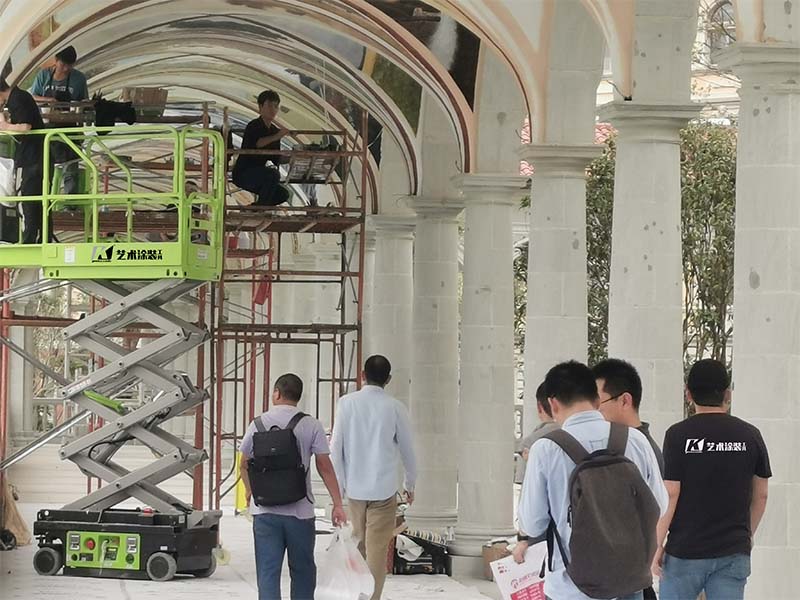
What does a bricklaying apprenticeship include?
A typical apprenticeship will last about 3 or 4 years. Some countries set a certain trading time, such as 8000 hours. Therefore, how many years it takes to complete depends on the workload of the apprentice. Other countries set the required number of years.
Time to complete a bricklaying apprenticeship
United States: 3 years
British Intermediate (Level 2): 2 years
UK Advanced (Level 3): 13-16 months
Australia: 4 years
New Zealand: 8000 hours (4 years)
Canada: 3 years
All apprenticeship programs will include classroom training and on-the-job training. Obviously, your company boss will oversee your workplace training, and then a bricklaying instructor will walk you through classroom lessons.
You will spend approximately 2 to 3 weeks in class throughout the year. The trade school tests and exams will match the experience you gain on the job. As you get closer to graduation, instructors will want to make sure you are competent in all aspects of Masonry.
Expect to build arches, around and behind fireplaces, read plans or blueprints, and learn about bricklaying standards and codes in your area. Completion of an apprenticeship usually results in official certification. This certificate can open up more opportunities.
Career Paths After Completing a Bricklaying Apprenticeship
Don't expect a promotion right after your apprenticeship ends. With only 3 or 4 years, generally no more than 7 years, you will still be relatively inexperienced. As you gain experience and skills, you can do your own apprenticeship training.
If you have good management qualities, you can be promoted to field supervisor or foreman. The ultimate goal of a bricklayer may be to become self-employed and start a business. Taking control of a business allows you to enter specialised areas of masonry such as heritage and restoration work or masonry.
Stop Wasting Time And Start HOW TO CUT BRICKS
Cutting bricks is an essential part of any brickwork job and as such, needs to be given the proper attention it deserves. Knowing how to cut a brick effectively can save you a lot of time and stress. This guide will help you to navigate this essential skill and discuss the various ways you can go about getting this task done right.There are two main ways of cutting a brick: By hand, or with a machine.
Brick Cutting by Hand
The first thing you’ll need to do is to decide on the size you need to cut your brick. Do you need to cut it down the middle, along the length, or across the width?
Once you know what size you need to cut the brick, it’s time to mark it out. Most times a permanent marker pen is good for this. You may choose a carpenter’s pencil, but remember you need to be able to see the line while you’re cutting it.
Firstly, your brick will need to be marked clearly at the size you need. Then the brick will need to be scored all around to weaken the point to be cut.
Using a hammer and chisel, or bolster, the basic technique is alternating sides. You’ll want to start at one end of your cut line and hit the chisel with a reasonable amount of force. You don’t want to try and break the brick with one hit, but you still need to impact it.
Work your way along from one end to the other, turn the brick over and go back again and it should break clean. It might take you one or two bricks to get the right force on your hammer hits, but once you know, you know.
Using a Bricksaw
If you’re using a bricksaw or other cutting machine, check to make sure the blade is going to be deep enough to go through the whole brick at once, or will you need to roll the brick over to get all the way through? Noting that in doing that, you’ll need to line up the cuts extremely well or you’ll end up with an uneven cut line that may prove annoying.
Mark out the brick to the size you need and be mindful of cutting blade thicknesses. The cutting blade of a bricksaw will take a few millimetres off as well, which may be an issue depending on the application. For example, brick paving can have some sections which may be quite unforgiving when it comes to tolerances.
Remember that when using a machine with water running over it, your marked line may get difficult to see.Put the brick into the carriage and line up the blade with your cut line by slowly moving the brick toward the blade without touching blade.
When ready, make sure your fingers are out of the way and push the brick steadily through the blade.Remove the two parts of the brick from the carriage and don’t throw the wrong one away!
Power Tools & Equipment for The Job
This really all depends on the application and whether you’re cutting an existing brick wall, or you’re cutting single bricks to fit into a specific spot. One of the biggest things to consider, no, THE biggest thing to consider is safety.
There’s no point doing things the easiest way you can think of and then ending up hurt. See, you can fit a circular saw with a masonry blade (but you also might lose a finger or three). On top of that, it also creates a lot of dust.
An angle grinder fitted with a masonry wheel can help you get into much tighter angles if that’s a requirement. Some of them can also have a vacuum fitted to them. The problem there is then you have a vacuum hose to drag around and get in the way.
If you’re cutting loose bricks and you’ve only got a couple of cuts to do, you can go with the old hammer and chisel. We’ll explain that process soon as it can be a handy skill to have, and it is an option. However, if you’re the serious brickie, or well-seasoned DIYer with the necessary skills, then you would want to consider a machine that makes cutting bricks look like child’s play (seriously though, do not let your kids play with these things!).
The Bricksaw has a smooth running 1800 watt electric motor and is definitely one of the most preferred choices for serious brick cutting. It suits a 14” blade and can cut up to 125mm deep and 500mm long. With its industrial extra heavy-duty carriage and head bearings it’ll cut through the job in no time at all.
Summary
If you’ve learned anything in the last few minutes we’ve been together, it’s that there’s more than one way to cut a brick. Technique Tools can offer you the quality tools for whichever way you want to go with it.
It is our honest hope that you find all of this extremely useful. However, this information is designed to be used as a guide only and you do need to consider building codes, regulations, techniques, available materials, and tools.
We are available to discuss your specific needs and can offer you professional advice for selecting the right tool for the job. We will always recommend the use of professional tradesmen when completing work requiring these skills.
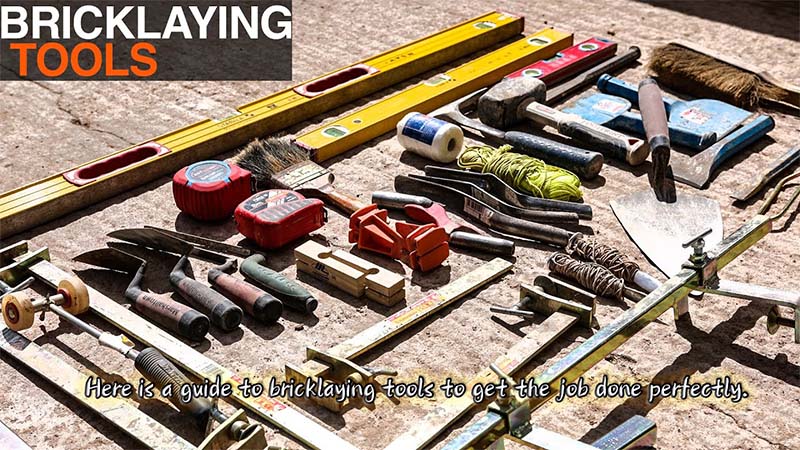
The Secret of Successful A GUIDE TO BRICKLAYING TOOLS
Bricklaying is an essential skill for a practised DIYer, and something that when done correctly, can bring a lot of satisfaction. It’s important to get the mortar mix correct, to choose the right bricks or slabs and to perfect your bricklaying technique. Here is a guide to bricklaying tools to get the job done perfectly. It is very important to use the correct tools.
In general, bricklaying tools can be categorised into four groups: trowels, string lines, joint tools and hammers. Each has an important role to play. Trowels are used for digging down and breaking up the surface so that the mortar can be applied more easily. String lines are used to stretch the bricks and joints together.
Bricklaying tools can help you get your work done quickly and efficiently.Successful bricklaying is reliant on havingthe right set of tools for each step of the process. Our strong and durable products are ideal for new walls, repairs or replacements. By helping you to provide the ideal finish, Bricklaying tools are an essential for any brickwork project.
Trowels or Spatula
Trowels are the most important bricklaying tool. Bricklayers use trowels for handling and shaping mortar and laying it between courses of bricks. Professional use trowels of different types and shapes for specific bricklaying tasks, but a brick trowel is probably most essential.
Traditional handles are made of hardwood, although modern trowel designs have softer grips designed for greater comfort and east of use. The blade of a trowel is made from steel – hardened and tempered carbon steel is commonly used.
Brick Trowel
Used to pick up and spread mortar, brick trowels are the largest of the trowel family. The two long edges of the trowel can either be dead straight or have a slight curve, known as a Philadelphia pattern.
Gauging trowel
A gauging trowel is smaller than a brick trowel. They have a distinctive rounded nose that is ideal for finishing large points and general patching of mortar.
Pointing Trowel
The pointing trowel is the smallest trowel a bricklayer will use. It is designed for pointing work.
Masonry Hammers
A building job may require a certain amount of shaping of bricks and masonry, and some jobs require masonry to be knocked into position. As most bricks are lightweight, a trowel is fine to use to tap them in place. Other types of masonry will require a much heavier mallet.
Rubber Mallet
Use a rubber mallet to knock bricks, slabs or other heavy masonry materials into place. The rubber head will cause little or no damage to the surface even when a heavy impact Is required.
Brick Hammer
A brick hammer is specifically designed for dressing bricks and masonry. Use the chisel-shaped peen opposite the square driving face to chip away sections of masonry.
Scutch Hammer
Scutch hammers are used for cutting bricks. They have a narrow end for striking the brick and a hammer end for applying force. The narrow end can be used in conjunction with brick combs to remove mortar or to make a surface rough for applying new mortar.
Joint Tools
Joints are key components of masonry work. Not only are they integral to a wall’s structure, but they also form part of the design, particularly in the case of brickwork. Usually a jointer is used only for new pointing. A raker is used for removing old mortar or producing patterned joints.
Brick Jointer
Brick jointers are used for finishing brick joints. Double-ended brick joints are used when you have two different joint depths.
Mortar Rakes
Before repointing takes place, use a mortar rake or joint raker to scrape out old mortar from the joints
String Lines
A string line is an essential bricklaying tool, enabling bricks to be laid level and straight. Usually they are held in place with line pins or blocks. The flat blade of the pins is inserted into the drying mortar at opposite ends of the wall. Polyethylene string (usually bright coloured) is then tied between the pins to form a guideline. (String normally made from nylon)
Other Useful Equipment
If carrying out bricklaying, you will need to have the appropriate safety gear such as gloves, eye protection and dust masks. You may also find brick tongs makes the job of carrying bricks a lot faster and easier. Measuring tapes are also essential, and a tarpaulin is great to keep workspaces tidy and to cover up the project if it rains.
Why 7 TIPS TO IMPROVE BRICKLAYING TECHNIQUE Is The Only Skill You Really Need
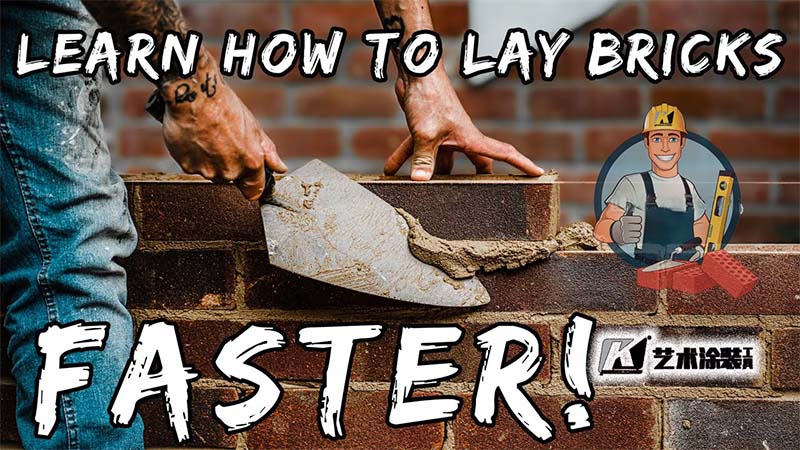
Do you want to keep improving your skills when you are already a junior DIYer or apprentice? Want to improve your quality / Want to lay bricks faster? Try these 7 very easy tricks:
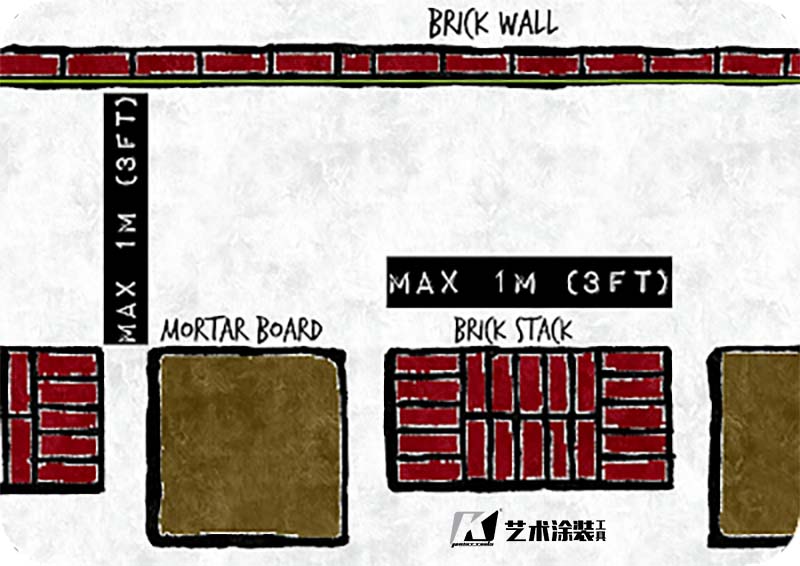
Setup your Brick-stacks and Mortar-boards in an Ture Efficient Place
A.Setup your Brick-stacks and Mortar-boards in an Ture Efficient Place
Don't try and make super long brick stacks. Try to pile them about 3ft (1m) long, and then place a mortar board in between each stack.
Keep a 3ft (1m) lane between your brick stacks and the wall you are building. This allows enough room for working comfortably but also means everything, ie bricks and mortar, are within a step or two. Time is saved not walking twice as far.
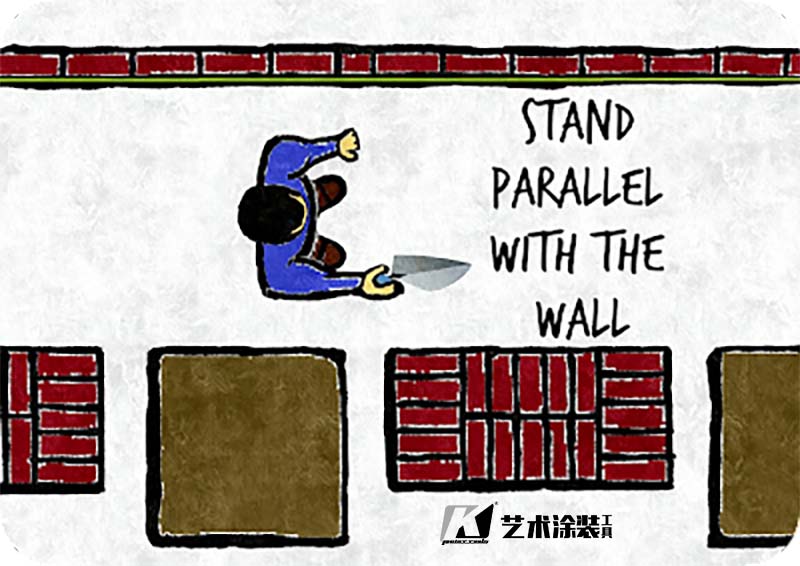
The Philosophy Of POSITION YOURSELF FOR BRICK LAYING
B. The Philosophy Of POSITION YOURSELF FOR BRICK LAYING
It's amazing how many new apprentices try to lay their bricks as they stand facing the wall. Stand parallel with it, keeping your trowel hand on the outward side.This allows you to sight your brick placement along the string line and also means you don't need to turn 180 degrees to pick up a new brick.
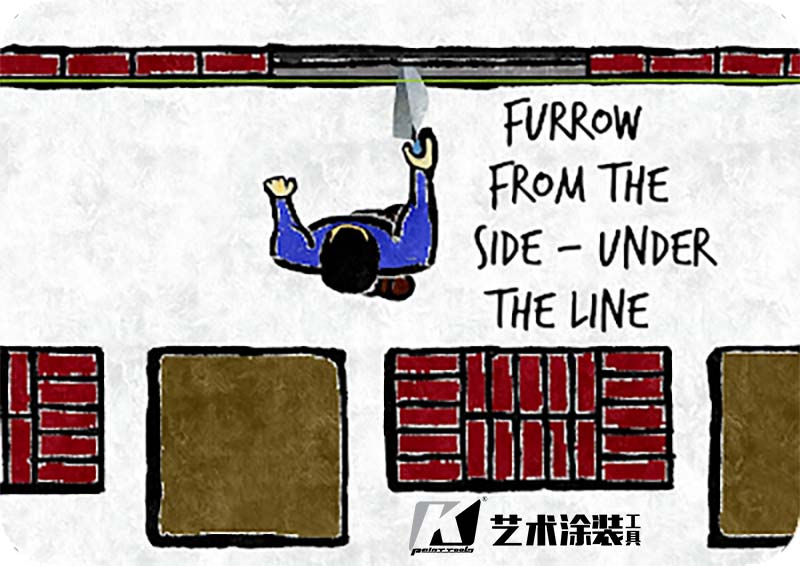
Furrow your Mortar Bed Correctly
C. Furrow your Mortar Bed Correctly
Furrowing is running your trowel through your bed creating a cavity in the middle.There are two common ways to do this. First keeping your trowel inline with the bricks, lifting it over the line and then pressing down into it.
The second is holding your trowel perpendicular to the bricks, coming underneath the string line and using the tip of the trowel to Furrow from the side. A lot of brickers prefer the later. Not only is it the fastest way to do it, but it also makes it easier to keep your trowel off the string line.
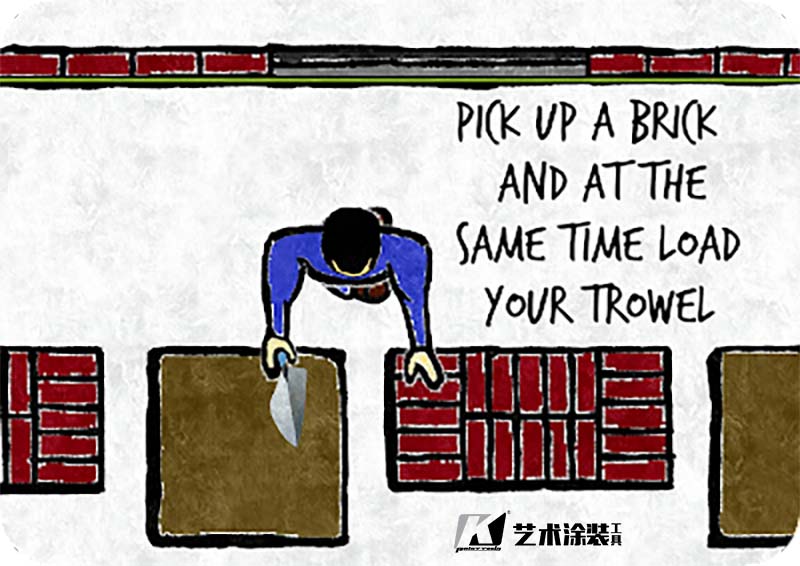
Picking-up Bricks and Loading your Trowel
D. Picking-up Bricks and Loading your Trowel
Make an effort to pick up the brick the way that it is layed in the wall. This saves you spinning it which costs time.Now some bricklayers will tell you to load your trowel with the excess mortar cut off from the last brick layed. This tends to work well with wider bricks but not so with thinner ones, at best only leaving enough mortar for one edge of the brick (a speed joint).
Some times the Pick and Dip Method can work well, it involves pressing a brick into an unfarrowed bed, squeezing the mortar up into the Perp-joint. So no need to butter the brick. However you do create large snots on the backside of the wall, and can fill up the cavity with wasted mortar. Inspectors might hit you up regarding this.
Another good technique to learn is called the "no look grab". You pick up a brick with one hand and at the same time load your trowel from your mortar board. You use your peripheral vision to line up both. It is only slightly slower than using excess mortar from the last brick and means you will always have enough mud to butter with a full joint.
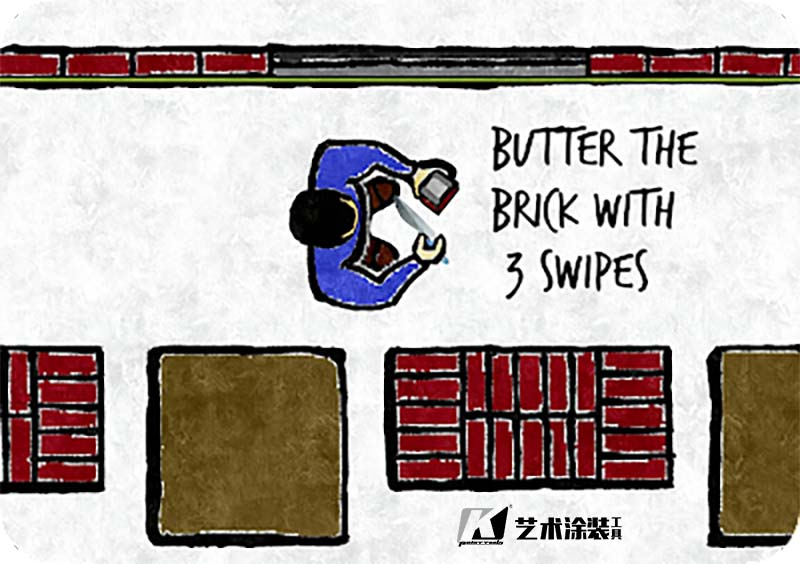
Buttering with a Full Joint
E. Buttering with a Full Joint
Many bricklayers use a speed joint or in other words they just butter one edge of the brick and place it in the wall. However buttering like this is more likely to leave holes when it's pointed and it also weakens the moisture barrier.
Learn to butter with a full joint. It's done in three swipes, the whole face then the two edges. If you find yourself with not enough mud from the last bricks excess try learning the technique in tip four.
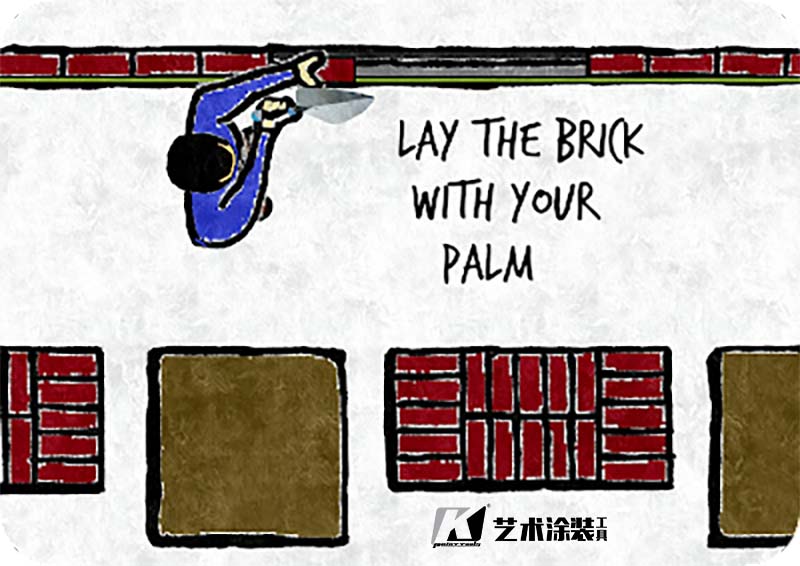
Laying the Brick to the Line
F. Laying the Brick to the Line
As you position the brick into place use your palm and fingers and with even pressure rub the brick down to the line - try to avoid using your trowel or handle to tap the brick into position. This will just wear out your trowel faster but more importantly it's slower than using pressure from your hand.
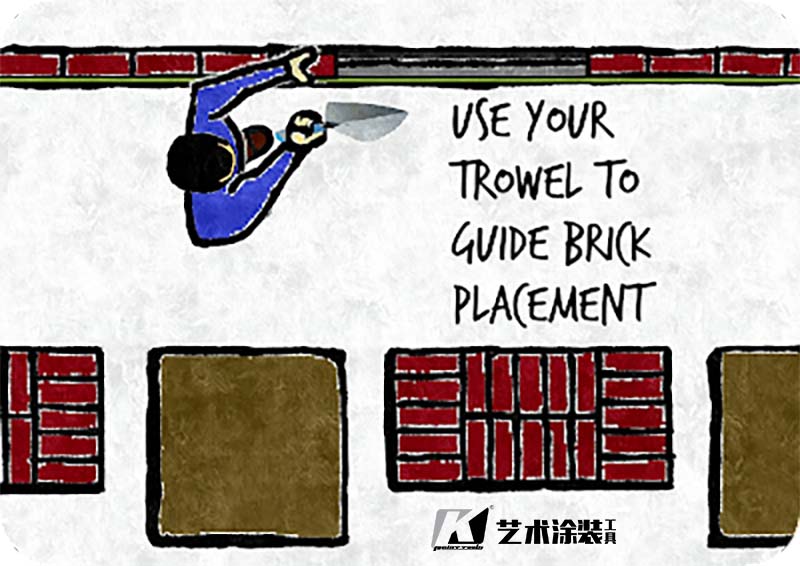
Cutting off the Excess Mortar
G. Cutting off the Excess Mortar
As you are laying the brick down to the line, keep your trowel in the position to cut off excess mortar but just hold it there. This gives an edge for the bottom of the brick to be laid against. When the brick is in position cut the excess mortar off. Doing this only once helps to avoid smearing on the face of the brick.
When you watch a good bricklayer you'll notice that they don't look like they're moving super quick. It's not about trying to be fast, rather real speed comes from focusing on efficiency of movement and rhythm. Try to get into a pattern of movement and then slowly refine those movements to build speed.
Keep your mind focused on this and in time you will be laying bricks like a pro
You have to be willing to put in the work and practice, if you want to be a great bricklayer. With practice, you will get better and better at the craft. If you can stay focused and keep your mind on the task at hand, you will become a pro in no time.















